Top 5 Important Types of VoIP Gateways Explained
VoIP Gateways are an integral component in carrier-grade VoIP Networks. They act as bridges between different VoIP and telecommunication networks. While this description might paint them in the same light as SBC, these two are not similar in many ways.
You can say that VoIP Gateways act more like bridges and SBCs are more like toll booths. Similar to bridges, different types of VoIP Gateways have their own unique place and function within a carrier-grade VoIP network.
Having the option to deploy specialized VoIP Gateways that excel at a certain function is beneficial to VoIP carriers in more ways than one.
In this blog, we shall learn about the 5 most important and common types of VoIP Gateways. This will help you choose and deploy the right gateway for your VoIP network, as and when the need arises.
Let’s get started then!
Analog VoIP Gateways
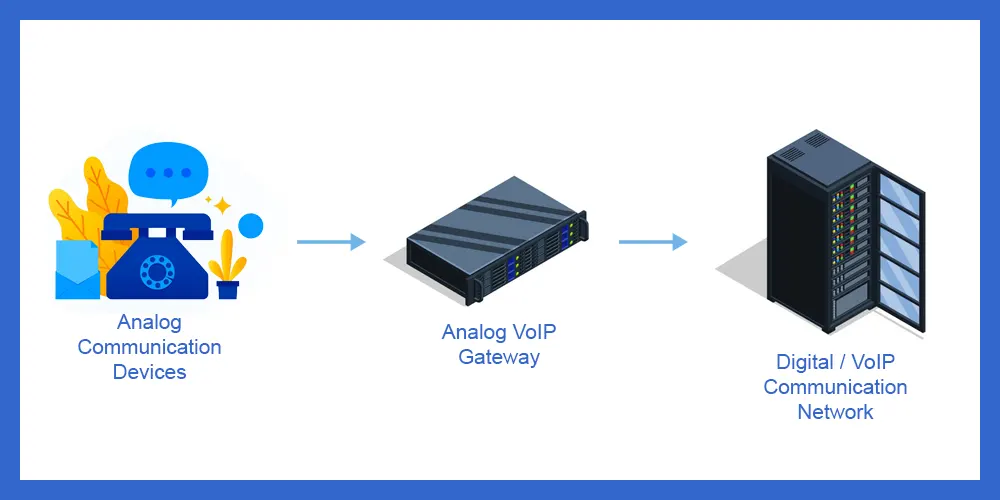
Bridging Traditional and VoIP Communication
Analog VoIP gateways are integral to VoIP networks. They serve as intermediaries that enable the seamless integration of traditional analog devices and communication networks with digital IP-based communication.
These gateways offer unique functions and features that are crucial in bridging the gap between analog and digital voice communication. Let's delve into what analog VoIP gateways are and explore their distinctive functions and features.
Functions and Features of Analog VoIP Gateways
1. Analog-to-Digital Conversion - Conversion of Voice Signals
The core function of analog VoIP gateways is the conversion of analog voice signals into digital data packets suitable for transmission over IP networks.
Thus, devices such as analog phones, fax machines, or analog telephone lines (PSTN) can communicate over the Internet.
2. Codec Support - Compression and Encoding
Analog VoIP gateways often incorporate various audio codecs (coder-decoder) to compress and encode voice data efficiently. These codecs optimize bandwidth usage while maintaining reasonable voice quality.
Common codecs used include G.711 for high-quality voice and G.729 for bandwidth efficiency.
3. Interface Ports - Analog and Digital Ports
Analog VoIP gateways typically come with a range of interface ports. These include analog ports for connecting analog devices and digital ports for connecting to ISDN or T1/E1 lines.
These ports enable the gateway to connect to diverse devices and networks.
4. Interoperability - Bridging Different Communication Technologies
Analog VoIP gateways facilitate interoperability between traditional analog telephony systems and modern VoIP networks. They ensure seamless communication between devices and networks that utilize different technologies.
5. Scalability and Configuration - Adaptability to Network Changes
Analog VoIP gateways are configurable and scalable, making them adaptable to changing communication requirements.
Whether a business expands or changes its communication infrastructure, these gateways can be configured and expanded to accommodate evolving needs.
Many businesses still use analog devices and PBXs. For such businesses, a VoIP Gateway can help reap the benefits of VoIP without requiring wide-scale changes.
Digital VoIP Gateways
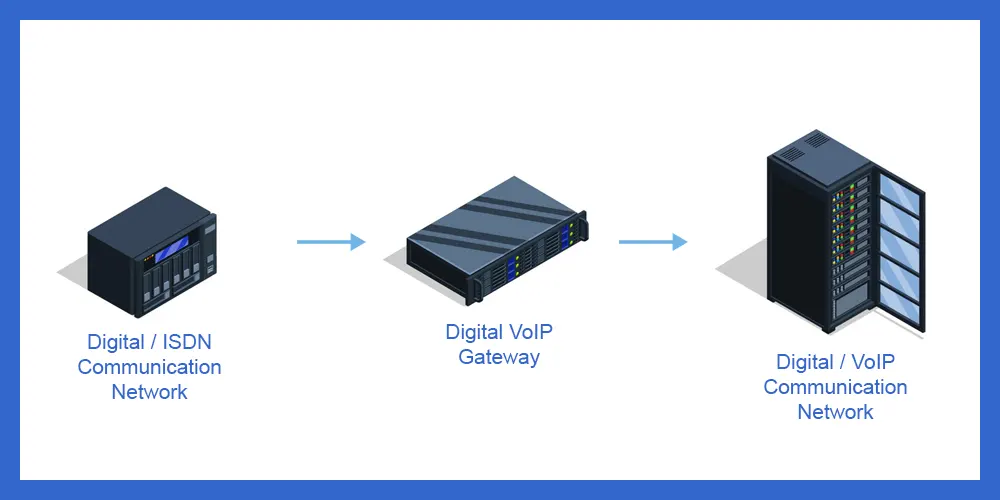
Enabling Integration of Digital Phone Systems
Digital VoIP gateways act as important bridges in VoIP networks. They are designed to facilitate the seamless connection of digital phone systems, such as ISDN (Integrated Services Digital Network) or T1/E1 lines, with VoIP networks.
These gateways offer several unique features and functions that are essential for bridging the gap between digital and IP-based voice communication.
Here, we will explore five of their distinctive features and functions.
Unique Features and Functions of Digital VoIP Gateways
1. Digital-to-Digital Conversion - Handling Digital Signals
Digital VoIP gateways excel at managing digital voice signals from phone systems like ISDN or T1/E1 lines. They do not need to perform analog-to-digital conversion because they receive signals in a digital format.
2. ISDN and T1/E1 Compatibility - Interfacing with Digital Phone Systems
These gateways feature interface ports compatible with ISDN and T1/E1 lines. Thus allowing them to connect seamlessly with digital phone systems. They ensure the smooth transition of digital voice traffic into VoIP-compatible data.
3. Codec Support - Efficient Data Compression
Digital VoIP gateways support various audio codecs to compress and encode voice data effectively. This feature optimizes bandwidth usage while maintaining voice quality.
Similar to Analog VoIP Gateways, common codecs used include G.711 for high-quality voice and G.729 for bandwidth efficiency.
4. Channelization and PRI Support - Managing Multiple Channels
Many digital VoIP gateways can handle multiple channels simultaneously, ensuring efficient management of voice traffic. They support PRI (Primary Rate Interface) connections, which are common in digital phone systems.
5. Voice Networking Protocol Conversion - Translating Digital Protocols
Digital VoIP gateways often perform the conversion between the protocols used in digital phone systems (like ISDN or T1/E1) and the SIP used in VoIP networks.
This protocol conversion allows voice communication to flow seamlessly between different network segments.
These unique features and functions distinguish Digital VoIP gateways. These specialized devices excel in handling digital voice signals, ensuring compatibility with ISDN and T1/E1 lines, etc.
SIP (Session Initiation Protocol) Gateways
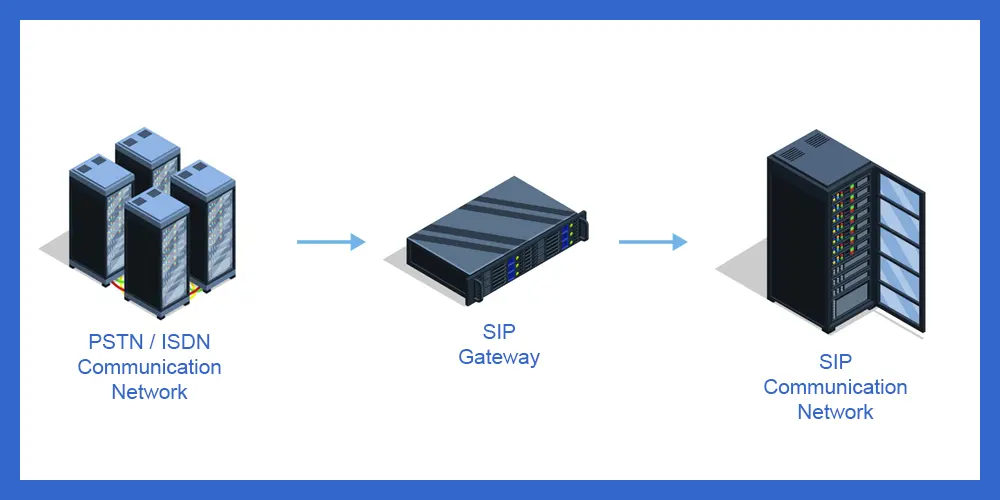
SIP VoIP Gateways: Enabling SIP-based VoIP Communication
SIP VoIP gateways are dedicated gateways that facilitate communication between traditional telephone systems and SIP-based VoIP networks.
These gateways offer unique features and functions that are vital for connecting different communication platforms.
Unique Features and Functions of SIP VoIP Gateways
1. Protocol Conversion - Translating Protocols
SIP VoIP gateways specialize in protocol conversion. They enable communication between SIP-based VoIP networks and traditional telephony systems that use protocols like PSTN (Public Switched Telephone Network) or ISDN. The gateway translates the signaling and control protocols to ensure seamless communication.
2. Call Routing and Control - Call Management
SIP VoIP gateways manage call setup and teardown processes, routing calls between different networks. They handle call admission control, call routing, and call termination, ensuring that calls reach their intended destinations.
3. Interoperability - Bridging Different Platforms
SIP VoIP gateways ensure interoperability between SIP-based VoIP networks and traditional phone systems. They enable communication between devices and networks that use different technologies, ensuring a smooth flow of voice traffic.
4. Security and Encryption - Securing Voice Traffic
Many SIP VoIP gateways incorporate security features like encryption and firewall capabilities to protect voice traffic from security threats and unauthorized access. This enhances the overall security of VoIP communication.
5. Quality of Service (QoS) Management - Ensuring Voice Quality
SIP VoIP gateways monitor and manage the Quality of Service (QoS) for voice traffic. They prioritize voice packets to minimize latency and packet loss, ensuring that voice quality is maintained at a high standard.
Thus, even though SIP Gateways seem similar to other Gateways, they’re not. The main act here is ensuring protocol translation and interoperability.
Media Gateways
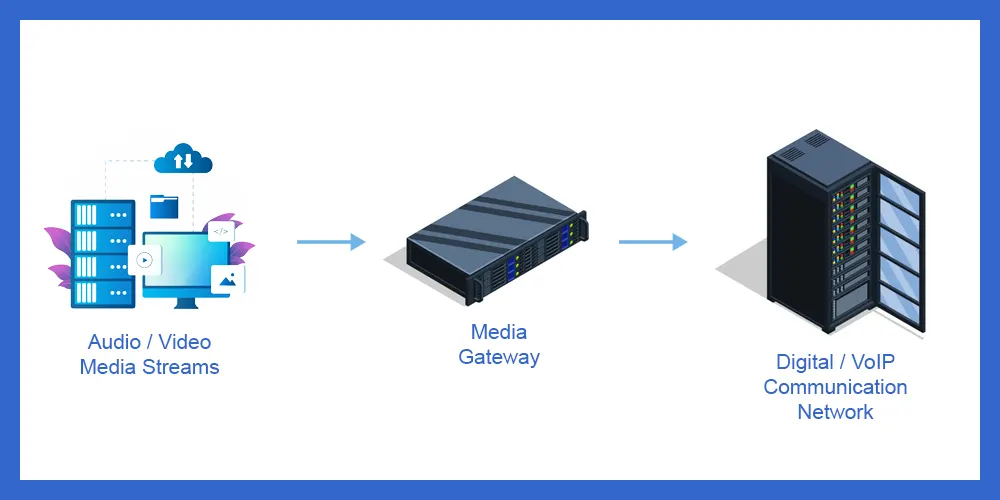
Media VoIP Gateways: Facilitating Multimedia Communication
Media VoIP gateways are specialized devices in VoIP networks. They are designed to manage multimedia content, including audio and video data.
These gateways offer unique features and functions that are crucial for various multimedia applications and communication scenarios. Let's delve into what media VoIP gateways are and explore five of their distinctive features and functions.
Unique Features and Functions of Media VoIP Gateways
1. Audio and Video Processing - Multimedia Handling
Media VoIP gateways excel at processing both audio and video data. They support audio codecs for efficient voice compression and video codecs for video communication. This allows them to manage multimedia content in real-time.
2. Transcoding - Format Conversion
These gateways often provide transcoding capabilities, allowing them to convert between different audio and video codecs. This is essential for ensuring compatibility between various endpoints with different codec preferences.
3. Conference Bridging - Multi-Party Communication
Many media VoIP gateways offer conference bridging features. They enable multi-party audio and video conferencing, facilitating collaboration and communication between multiple participants.
4. Interactive Communication - Real-Time Interaction
Media VoIP gateways are well-suited for interactive communication scenarios, such as video conferencing, live streaming, and remote collaboration. They manage the real-time transmission of audio and video content.
5. Content Management - Media Routing and Switching
These gateways can route and switch media content between different endpoints. Thus ensuring efficient data flow during multimedia communication.
They also play a role in managing the Quality of Service (QoS) to maintain high-quality multimedia communication.
While differences between other gateways aren't so substantial, the case isn't the same with Media Gateways. These are specialized gateways with a singular focus - media and media management.
Trunking Gateways
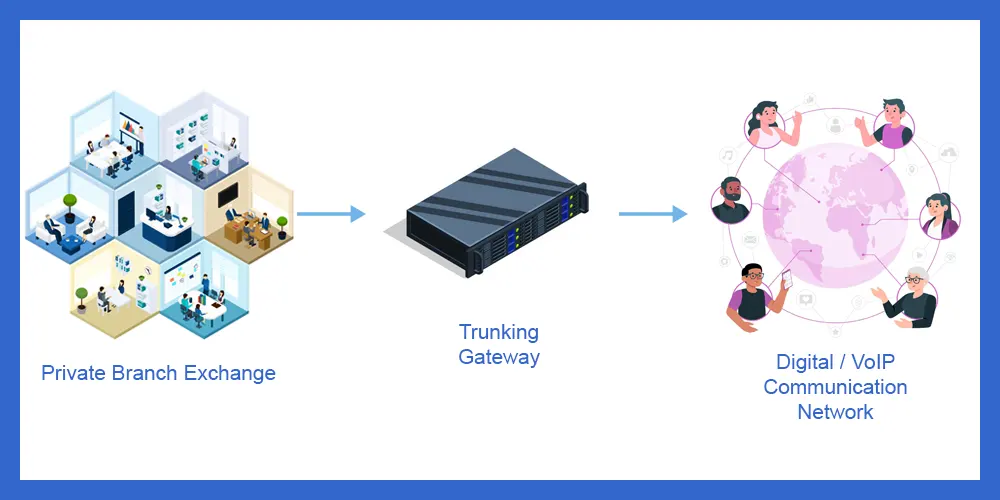
Trunking VoIP Gateways: Streamlining Voice Traffic for Businesses
Trunking VoIP gateways are like highways for the telecommunication networks. They focus on connecting multiple lines or channels from a Private Branch Exchange (PBX) to VoIP networks.
These gateways offer unique features and functions that are crucial for efficient call routing and connectivity in business communication. We will explore what trunking VoIP gateways are and detail a few of their distinctive features and functions.
Unique Features and Functions of Trunking VoIP Gateways
1. Channel Aggregation - Consolidating Multiple Channels
Trunking Gateways aggregate multiple voice channels or lines from a PBX system into a single connection to any external VoIP network. This consolidation reduces complexity and optimizes the use of voice resources.
2. Call Routing and Load Balancing - Efficient Call Management
These gateways excel at call routing, load balancing, and distributing voice traffic across the VoIP network. They ensure that calls are efficiently directed to their destinations and prevent network congestion.
3. Scalability and Redundancy - Adaptability to Growing Needs
Trunking VoIP gateways are scalable, allowing businesses to expand their communication infrastructure as needed. They also offer redundancy features to ensure uninterrupted communication in case of hardware failures.
4. Interoperability and Protocol Conversion - Connecting Different Protocols
These gateways support interoperability by connecting various protocols used in PBX systems and VoIP networks. They ensure seamless communication by performing protocol conversion.
5. Quality of Service (QoS) Management - Voice Quality Optimization
Trunking VoIP gateways monitor and manage the Quality of Service (QoS) for voice traffic. They prioritize voice packets, minimize latency, and ensure that voice quality remains high during communication.
Thus, while still similar to others, Trunking Gateways are unique in significant ways.
With that, we’re at the end of our list. Let’s wrap things up!
Concluding
You can be picky when it comes to choosing a VoIP Gateway. There’s most definitely something special for your particular set of communication requirements.
While these are still similar when it comes to core functionality, they have their unique flavors just like ice cream does.
The VoIP Gateway types we covered today are among the most common ones. We will also be covering some unique types soon in the upcoming blogs.
I hope this blog has been helpful to you in understanding the different capabilities of each type of VoIP Gateway covered.
























































































































